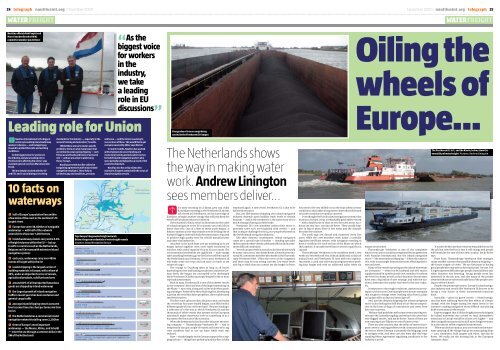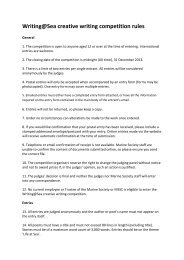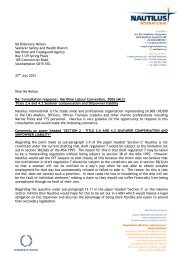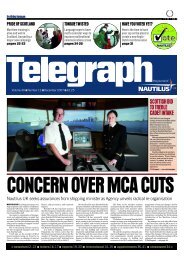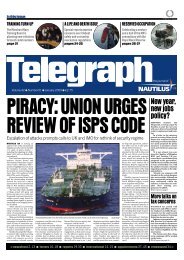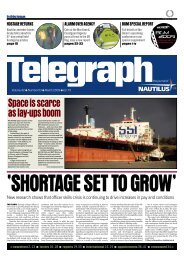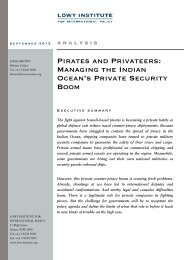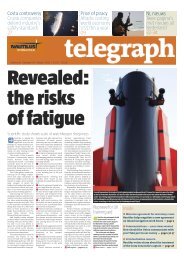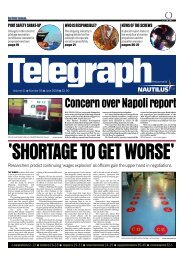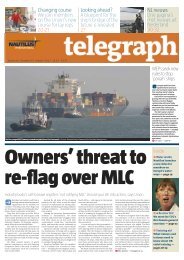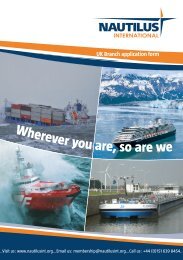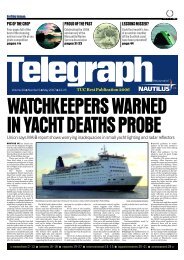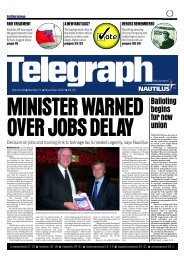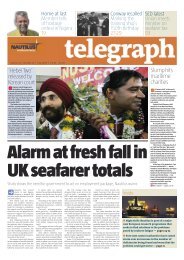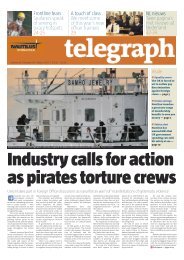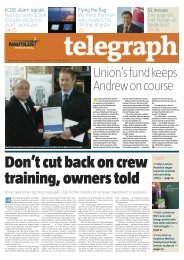NAUTILUS P01 NOVEMBER 2009.qxd - Nautilus International
NAUTILUS P01 NOVEMBER 2009.qxd - Nautilus International
NAUTILUS P01 NOVEMBER 2009.qxd - Nautilus International
You also want an ePaper? Increase the reach of your titles
YUMPU automatically turns print PDFs into web optimized ePapers that Google loves.
24 | telegraph | nautilusint.org | November 2009 November 2009 | nautilusint.org | telegraph | 25<br />
WATER FREIGHT<br />
<strong>Nautilus</strong> officials Rob Pauptit and<br />
Marcel van den Broek with NL<br />
committee member Jan de Rover<br />
10 facts on<br />
waterways<br />
z half of Europe’s population lives within<br />
a few miles of the coast or the continent’s 15<br />
largest rivers<br />
z Europe has some 38,000km of navigable<br />
waterways — with half of the network<br />
accessible to ships over 1,000 tonnes<br />
z inland waterway vessels carry some 6.6%<br />
of freight volumes within the EU — but up<br />
to 42% in countries such as the Netherlands,<br />
Belgium and Germany with extensive inland<br />
navigation systems<br />
z each year, waterways carry over 485m<br />
tonnes of freight within the EU<br />
z inland shipping is the largest carrier of<br />
building materials in Europe, with a share of<br />
39%, and is an important carrier of cereals,<br />
agricultural products, solid fuels and ores<br />
z around 80% of all transported hazardous<br />
goods are shipped by inland waterways<br />
z the largest growth of inland navigation<br />
traffic in recent years has been container and<br />
general cargo traffic<br />
z average inland shipping vessels consume<br />
four to seven times less fuel per tonne-km than<br />
lorries<br />
z the Netherlands has a commercial inland<br />
navigation network totalling some 2,200km<br />
z three of Europe’s most important<br />
waterways — the Meuse, Rhine, and Scheldt<br />
— enter the sea through a common delta in the<br />
SW of the Netherlands<br />
As the<br />
“ biggest voice<br />
for workers<br />
in the<br />
industry,<br />
we take<br />
a leading<br />
role in EU<br />
discussions<br />
”<br />
Leading role for Union<br />
<strong>Nautilus</strong> <strong>International</strong> is the biggest<br />
Munion representing inland waterway<br />
workers in Europe — and is stepping up<br />
its work to protect their jobs and working<br />
conditions.<br />
‘As the biggest voice for workers in<br />
the industry, we take a leading role in<br />
EU discussions affecting the sector,’ says<br />
assistant general secretary Marcel van den<br />
Broek.<br />
‘We are deeply involved with the ITF<br />
and ETF, and in social dialogue in setting<br />
standards for the industry — especially in the<br />
areas of training and education,’ he adds.<br />
‘Whilst there are some sector-specific<br />
problems, there are also many issues that<br />
are similar to ocean-going shipping — such<br />
things as workloads and hours of work and<br />
rest — and we are active in addressing<br />
these,’ he says.<br />
<strong>Nautilus</strong> presently has five collective<br />
bargaining agreements with major inland<br />
navigation employers. These help to<br />
set decent pay and conditions, pensions<br />
and leave — and the Union is seeking to<br />
secure more of these. ‘We would like to get<br />
everyone covered by CBAs,’ says Marcel.<br />
In recent months, <strong>Nautilus</strong> has worked<br />
with employers to secure funding and<br />
create new training and education courses<br />
for Dutch inland navigation workers who<br />
were partially unemployed as a result of the<br />
economic downturn.<br />
<strong>Nautilus</strong> also has a ship visitor who<br />
maintains frequent contact with the crews of<br />
inland navigation vessels.<br />
Top: Europe’s huge waterfreight network<br />
Below: the green credentials of waterfreight vessels<br />
Graphics: Inland Navigation Europe<br />
Four grades of iron ore cargo being<br />
carried in the Veerhaven IX’s barges<br />
The Netherlands shows<br />
the way in making water<br />
work. Andrew Linington<br />
sees members deliver...<br />
C<br />
It’s early morning on a damp, grey and chilly<br />
Rotterdam morning as the Veerhaven IX moves<br />
off a berth at Dintelhaven, on the outer edge of<br />
Europort, to begin another voyage that will help keep the<br />
wheels of European industry in motion.<br />
If you wanted to find a vessel to demonstrate the value<br />
of inland navigation to the EU economy, you could do no<br />
better than this. One of a fleet of seven ‘push-barges’, it<br />
helps to operate a non-stop shuttle service feeding one of<br />
Europe’s biggest steel mills with the raw products required<br />
to produce high quality steel for vehicle manufacturers<br />
and other vital industries.<br />
Attached to the push-boat unit are anything up to six<br />
barges lashed together with steel ropes tensioned by<br />
winches, with a total capacity of up to 16,500 tonnes. The<br />
environmental credentials are significant — each voyage<br />
takes anything between 440 to 660 lorries off the roads of<br />
the Netherlands and Germany. Over a year, Veerhaven IX<br />
will make some 200 trips and can carry as much as 2m<br />
tonnes of cargo.<br />
The voyage to Duisburg takes as long as 28 hours,<br />
depending on river and loading conditions, and at the German<br />
berth the barges are uncoupled to be discharged<br />
while Veerhaven IX lashes up empty barges for the 12-hour<br />
trip back downstream.<br />
Built in 1999, Veerhaven IX is one of the newest vessels<br />
in the company’s fleet and one of the largest operating on<br />
the Rhine — up to 269.5 long and 22.8m wide when pushing<br />
six barges. Powered by three Mak engines, developing<br />
5,400hp, the vessel has three propellers, three rudders and<br />
two bow thrusters.<br />
The fleet runs 24 hours a day, 365 days a year, and today<br />
the vessel has four part-loaded barges, each filled with a<br />
different grade of iron ore from Brazil. The part-loading is<br />
a reflection of a the way in which Veerhaven IX and the<br />
thousands of other vessels that operate on the European<br />
mainland’s major waterways serve as something of as a<br />
barometer for the state of the economy.<br />
When the downturn kicked in earlier this year, the owning<br />
company — Thyssenkrupp Veerhaven BV — had to<br />
temporarily lay up a couple of vessels and some of its 154<br />
crew members had to use up leave while work was<br />
reduced.<br />
Now — thanks largely to the German support for scrapping<br />
old cars — things have picked up and the fleet is fully<br />
employed again. A new vessel, Veerhaven XI, is due to be<br />
delivered next year.<br />
But, just like deepsea shipping, the inland navigation<br />
industry depends upon healthy trade levels to remain<br />
buoyant — and at the moment it is the same story of too<br />
much tonnage chasing too little trade.<br />
Veerhaven IX’s crew members reckon their sector is<br />
presently some 30% over-supplied with vessels — and<br />
that’s a major challenge for the 14,000 people who work in<br />
the Dutch inland navigation industry.<br />
Like their deepsea counterparts, inland navigation<br />
crews are a special type of worker — needing specialist<br />
skills to operate their vessels safely and efficiently in sometimes<br />
difficult conditions.<br />
‘Vessels can pass within 10m of each other, which would<br />
be a near-miss at sea,’ says Jan de Rover, a <strong>Nautilus</strong> <strong>International</strong><br />
NL committee member who works in the Thyssenkrupp<br />
Veerhaven fleet. ‘Often the river can be congested,<br />
and there may be very strong currents, low water levels<br />
and fog so thick that you cannot see the barges in front.<br />
You need to be very skilled to run the ship safely in these<br />
conditions, and it takes a long time to learn those skills and<br />
to learn to read the river and its currents.’<br />
Even though the Dutch inland navigation system is the<br />
busiest in Europe, it has a remarkably good safety record<br />
— with a fatality rate of close to zero in recent years. ‘Accidents<br />
are very rare,’ says Jan de Rover. ‘They usually happen<br />
in fog or when there is low water and the channel<br />
becomes very narrow.’<br />
The push-tugs are classed and inspected every five<br />
years, while the crew members work under a carefully<br />
regulated certificate system, with navigators needing to<br />
have a certificate for each section of the Rhine on which<br />
they operate. It can take more than 10 years to qualify as a<br />
captain.<br />
Thyssenkrupp Veerhaven crew members work a two<br />
weeks on/two weeks off rota, with an additional 20 days of<br />
annual leave, and Veerhaven IX runs with two captains,<br />
two mates, a cook, one sailor and an engineer when pushing<br />
four barges and with an additional sailor when six<br />
barges are attached.<br />
Thyssenkrupp Veerhaven is one of the companies<br />
whose crews are on conditions regulated by an agreement<br />
with <strong>Nautilus</strong> <strong>International</strong>. But the inland navigation<br />
sector — like international shipping — is fiercely competitive,<br />
with increasingly intense pressures affecting operators<br />
and crews.<br />
Many of the vessels operating on the inland waterways<br />
are ‘privateers’ — often run by husband and wife teams,<br />
supplemented by a professional crew member, for whom<br />
the vessel is a home as well as their business. Recent years<br />
have seen a big influx of new tonnage, and with the economic<br />
downturn the market has been hit by over-capacity.<br />
In response to the tough conditions, operators are trying<br />
to cut their costs. One example was a private company<br />
that sought to change crews’ working rotas from 14 days<br />
on/14 days off to 21 days on/seven days off.<br />
And, just like deepsea shipping, the inland navigation<br />
sector is also feeling the chill wind of cut-throat competition<br />
in the form of flags of convenience and crews from<br />
low-cost countries.<br />
‘We have had problems with some owners putting vessels<br />
onto the Luxembourg flag, and we have also seen Maltese-flagged<br />
vessels,’ said Jan de Rover. ‘Some of them are<br />
now starting to use Filipino or even Chinese crews.’<br />
There are also concerns that the influx of eastern European<br />
crews is creating problems with communications in<br />
the sector, where German is presently the language used<br />
to navigate with. And there are also fears that the longstanding<br />
Rhine Agreement regulating conditions in the<br />
industry is at risk.<br />
WATER FREIGHT<br />
Oiling the<br />
wheels of<br />
Europe...<br />
The Veerhaven IX, left, and the Alsvin, below, show the<br />
versatility of waterfreight Pictures: Andrew Linington<br />
‘It used to be the case that everyone was paid the rate for<br />
the job, but now the fear is that it will change and people<br />
will be paid at the rate of their own country,’ Jan de Rover<br />
says.<br />
Peter Buur, Thyssenkrupp Veerhaven fleet manager,<br />
raises another concern that parallels deepsea shipping —<br />
the future supply of crews. ‘’We are fortunate in having<br />
good people who stay with us for many years,’ he says, ‘but<br />
it is getting more difficult to get people, especially last year<br />
when business was booming. Young people seem less<br />
interested in the job now, and also many of the private<br />
owners with one or two vessels take lots of the people coming<br />
out of the schools.’<br />
Despite the present pressures, Europe’s inland navigation<br />
industry and vessels like Veerhaven IX deserve to be<br />
facing a rosy future in these environment-conscious<br />
days.<br />
Ironically — given its ‘green’ merits — inland navigation<br />
has been suffering from the first effects of climate<br />
change, with the longer-lasting low water levels in the<br />
summers making navigation more difficult and placing<br />
draft restrictions on the vessels.<br />
Experts suggest that if all the freight presently shipped<br />
by inland waterways was carried by road, atmospheric<br />
emissions in Europe would be at least 10% higher — and<br />
there is significant potential to shift more freight to water,<br />
in stark contrast to the congested road network.<br />
‘When you look around us, you see vessels on the waterways<br />
carrying all the things that go on ocean-going ships<br />
— cars, containers, bulk cargoes and more,’ says Jan de<br />
Rover. ‘We really are the missing link in the European<br />
transport chain.’


